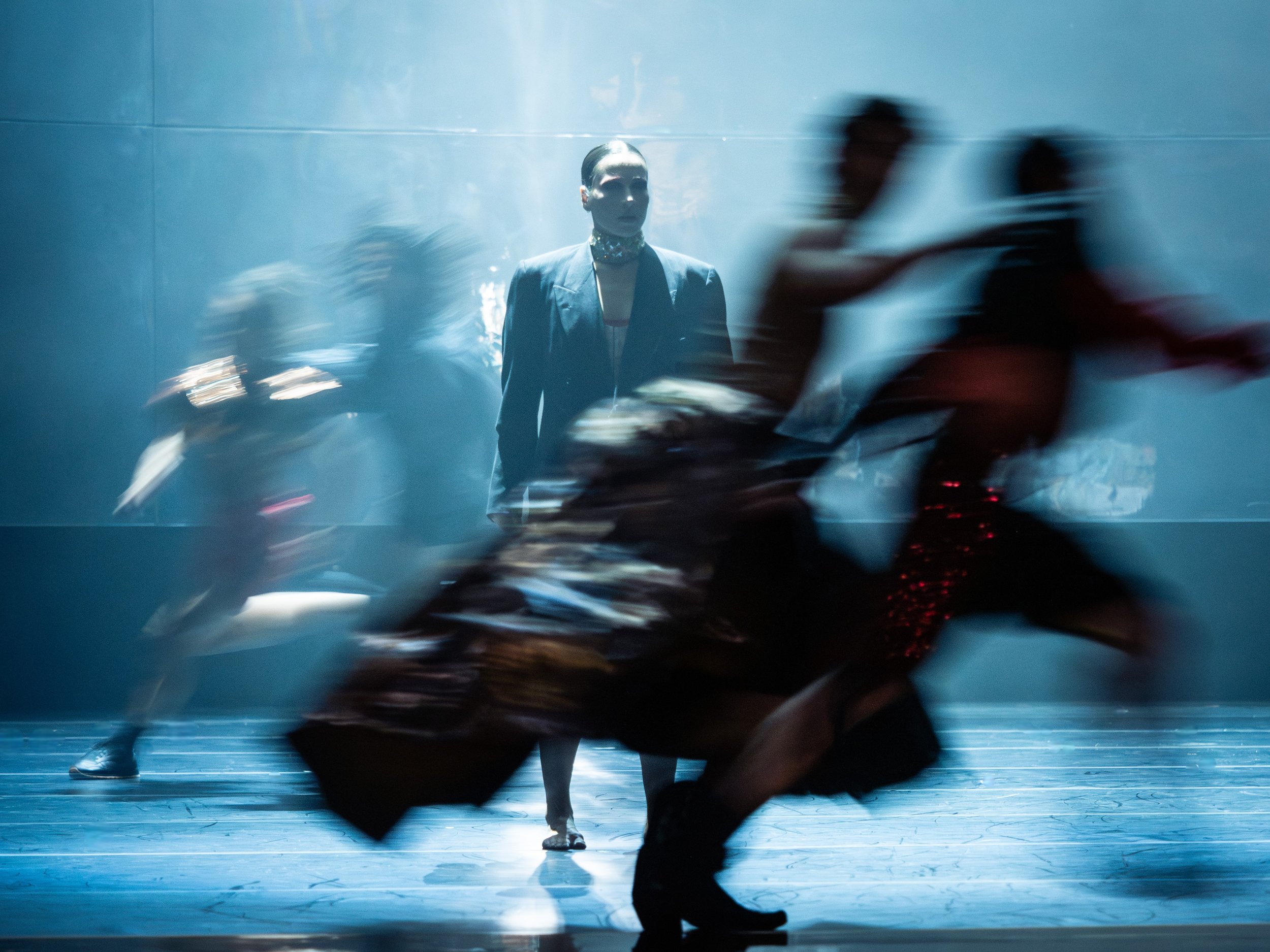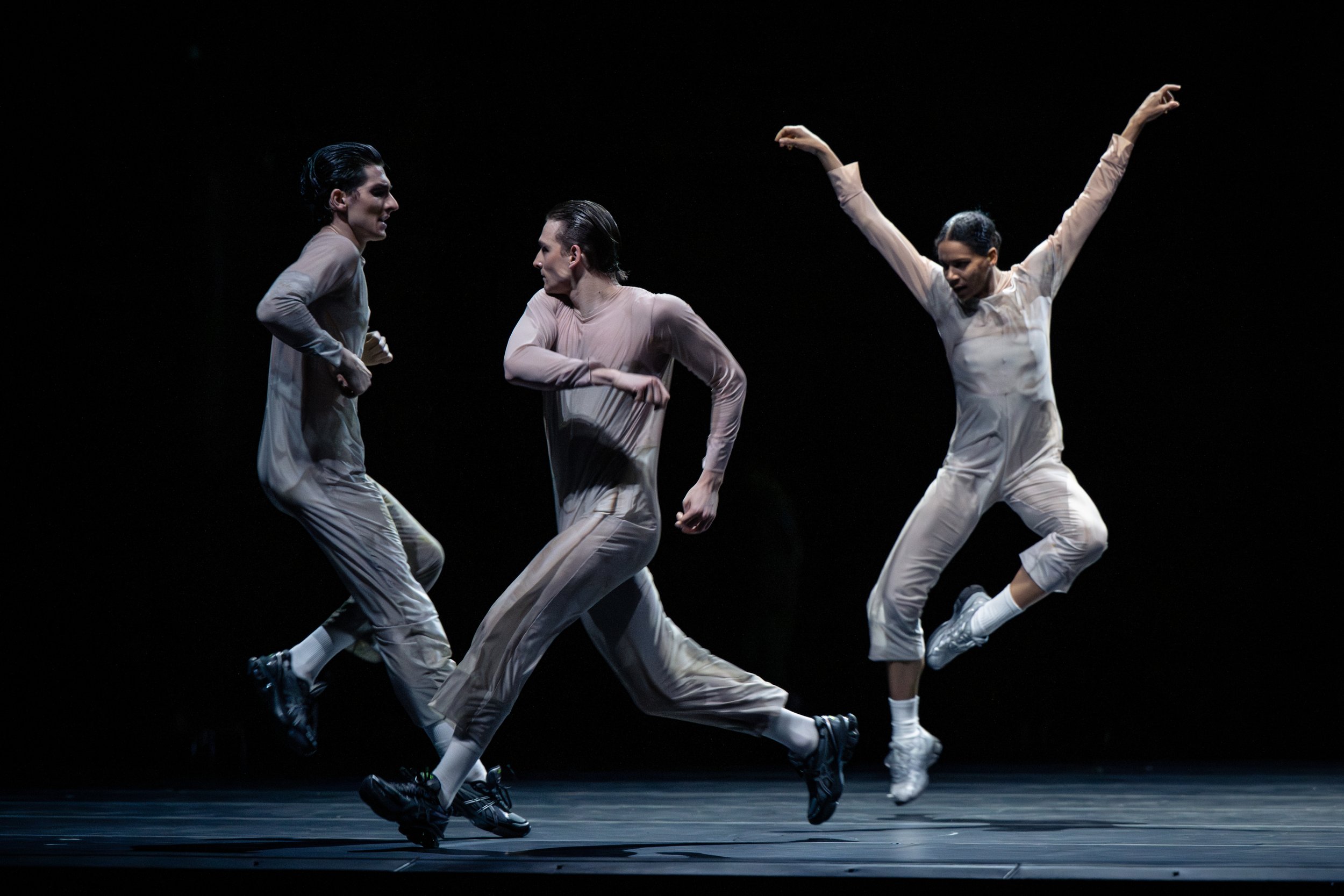„Creations", Vienna State Ballet (Wiener Staatsballett), Volksopera, June 27th, 2025
„Creations", Vienna State Ballet, Volksopera, June 27th, 2025
I had not planned to see this show. It did not interest me. But happenstances made me change my mind. At the very last minute
It has been years, no, decades, since we (only) witnessed rare „novelties" in the world of Contemporary Dance. Nowadays, everything seems to be the same, somehow either copied or already „seen before"...
The dancer singing, the running around, flexed feet during lifts that tend to be more neoclassic (giving them a more contemporary touch), the non-use of music (using the “rule” of just beginning and ending at the beginning and end of it), the shades of dancers behind a wall interacting with the dancers in the front of it, and the list goes on and on.
Nothing new.
It has all been seen before. Somehow, I see the dancers still on the spot where I stood so many years ago (the sets are a bit different).
The biggest problem does not lie in the repetitiveness of it all, but in the “belief” that these “creators” are doing something „new". In times where everything should be so transparent, people do not realise that there is also „a past" (which is easy to research), and just very few (exceptional) creations can be found there.
I shan't ever forget Zdenek Hampl's enlightening words to me. Zdenek (1946-2007), an ex-dancer of (former) Czechoslovakia's „Lanterna Magika" and a master of the contemporary sector. He was just referring to pseudo, „disposable" intellectuality. Especially how it can be totally „out of place" when connected to contemporary Dance. It „gives the game away". This can be confirmed when read in the many programmes that have been created by people who are trying to resemble „experts" - sometimes just for the „edification" of other experts.
He said: „When you open a programme and you find there beautiful, well-formulated, intellectual descriptions of the works you are going to see, by the choreographer, you'll know what I mean: This is literature, not dance. A dancer and a good choreographer master only one language. The language of Dance. All other „formulas" of expression are not worth mentioning when referring to Dance."
Yesterday, as I opened my programme, I did not want to read about the ballets. I must confess that all three choreographers were completely “no-names” to me, and I was hoping (against my principles of never reading a programme until after the show and after having written my review) to get a glimpse or two of their “biographies”. By chance, I sort of stumbled on descriptions that fit more than perfectly Mr Hampl's principles. And I knew that very minute, this was no "enchanted evening" ahead of me.
As in the past months, most of the leads were once more danced by dancers whose contracts are not going to be renewed next season and, therefore, are not going to work with Alessandra Ferri, the new director who starts „officially" her work next September.
Copyright: Ashley Taylor & Vienna State Ballet
Alessandra Corti's „Aerea", is a piece, supposedly, about „identity".
Well, allegedly.
It could be about many other things.
Or none of them.
Once more, the sort of dramaturgical work which only takes place in the choreographer's mind, never finding its way to materialise in the Performing Arts.
The sort of repetitious „dance" in which music is unnecessary, as the choreography is not written to it.
Copyright: Ashley Taylor & Vienna State Ballet
The few dance steps or sequences are always interrupted by some „running around". Just to land in another short version of a sequence, which is once more interrupted by another round of „running around". And this goes on and on. Yes, “running around”. An easy way to have a solution to a choreography when inspiration has left you.
It is interesting to note that, against all „predictions" made by Mr Schläpfer at the beginning of his directorship period, the Corps de Ballet from the Volksopera was again on its own, „hermetically sealed" so to say, and in no contact whatsoever on stage with the State Ballet. As if the company were an “extra part” of the troupe. Is it so again as in the past?
After the intermission, many places on the orchestra level were left empty. One must observe that strong applause came either from the first or from the second balconies, which were 48 hours before the performance, still quite empty.
The public yesterday was divided into two fractions: one, the usual Volksopera goers at the Orchestra level and a significant number of a different public on both balconies. Last-minute bookers? Interesting.
Copyright: Ashley Taylor & Vienna State Ballet
Louis Stien's „High" showed some „improvement" in comparison to the „opening act". There was also quite a “dose” of „running around", but more discreetly executed and disguised.
At least there was an attempt to register a certain „vocabulary" of movements into the choreography.
Nothing of a prodigy, very median in fact. But a try.
After the second intermission, there were even more empty seats on the Orchestra Level.
Curtain up to Martin Chaix's „M to M"
The first two pieces had been so pathetically paltry that I caught myself quite excited when the third part began. Just by giving us glimpses of movements.
There was music, and a choreography fitting it.
There were better costumes, even if the lighting was kind of thrifty.
More Rhythm, more dynamic. More Dancers.
More use of the sets.
Everything that one automatically „awaits" when watching a dance performance. But it was not enough..
Shouldn't the above-mentioned „ingredients" be quite „obvious"? I could nearly understand why audiences last year gave heart-warming applause when the curtains went up and one could see ballerinas wearing tutús in some Balanchine piece. Yes, audiences in Vienna have been starved for that.
After the first two pieces that preceded this, I too was starving for dancing...
Copyright: Ashley Taylor & Vienna State Ballet
„M to M" is also an attempt, but a much better one than the two previous works. To be very honest, it just „fared" better because of the dilettantism of the first two pieces.
Heart-warming: Ketevan Papava’s, Masayu Kimoto’s, Ioanna Avraam’s and Timmoor Afshar's Performances.
Copyright: Ashley Taylor & Vienna State Ballet
Interestingly, this time, as expected, the strong applause came from the audience on the Orchestra level and not from the balconies.
As a Summary, one can only refer to this most unsuccessful evening, which was called „Creations" (!?!?!) as a tired, inadequate, uninspired, and inapt attempt to fill a gap at the end of the Season and display the present's direction as visionary", on its finishing duty days, as if investing in „Newcomers" (Although Miss Corti and Mr Chaix can hardly be called that) would be the only answer to all problems that this team was confronted with during the last “roller coaster ride” five years, after the brilliant Manuel Legris’ period, in which the State Ballet came to its best technical and artistic level in history.
All this is proof that the Volksopera concept as an “extension Opera House” to the Vienna State Opera was completely overlooked by the team. I do not blame them for coming from German provincial theatres, and for the fact of sitting presumptuously, and contentedly, in a comfort zone of their own making, honestly believing that they would, should, and could teach the Viennese audiences to „think" and “rethink”. It is not arrogance (as some believe it to be), and it is not their fault for not having previous international experience. The error lies in the lack of insight in giving them these positions. I warmly recommend in cases like this an earnest read of Stephan Zweig's „The World of Yesterday"! There's no better way to explain the difference between Austrian and German mentalities and their completely different perspectives on life. Apart from the fact that it is never too late to try to understand the „public" of a theatre, and its internationalism, as in the case of the State Opera.
The Volksopera and its public are no exception to this. Without the necessary comprehension of a House and its public, peculiarities, habits, and traditions, there'll be no possible CHANCE OF CHANGE IN THE FUTURE. No possibility of winning a new public. And this is what old institutions are looking for. Vienna is no exception.
Things here happen „peu à peu" and not on command.
But how does the saying go? "Physician, heal thyself".
An ancient proverb that emphasises the importance of addressing one's own shortcomings before attempting to correct those of others, as I have heard many times about the present team.
It highlights the hypocrisy of pointing out flaws in others while ignoring them in oneself and also underscores the need for self-reflection and personal growth. Think of that.
Ricardo Leitner
a t t i t u d e
Vienna, June 28th, 2025










